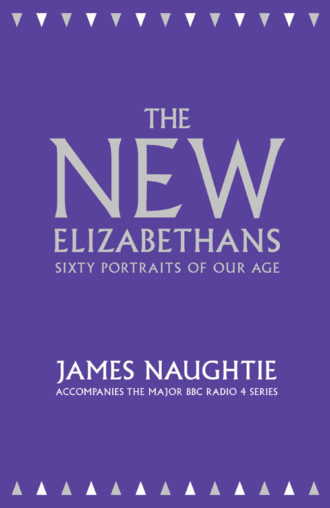
Полная версия
The New Elizabethans: Sixty Portraits of our Age

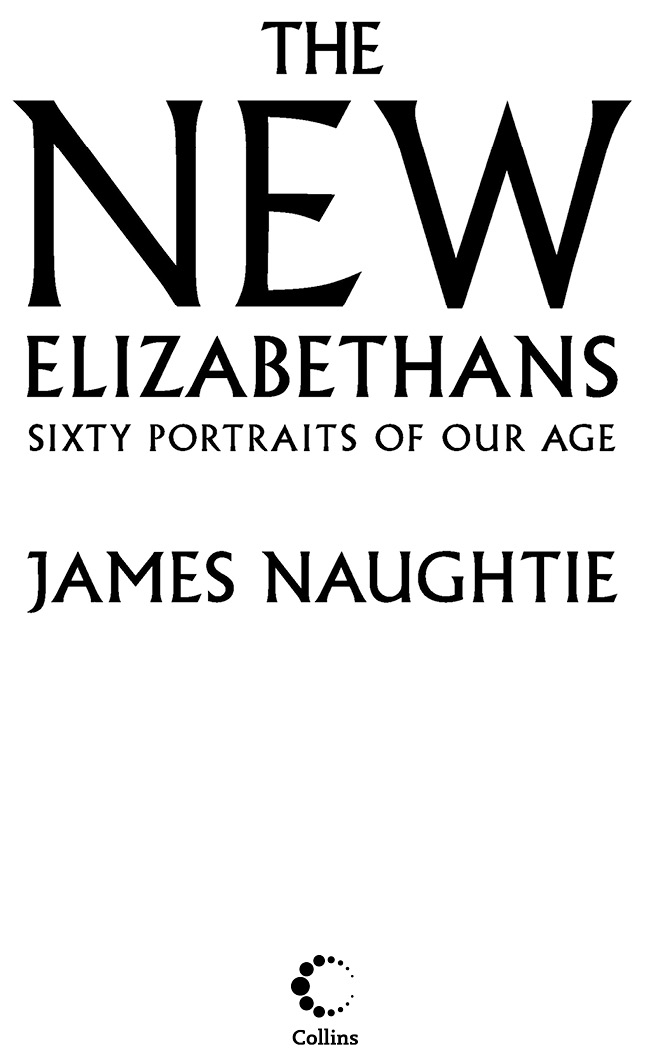
Contents
Picture Section
Introduction: Our Age
Edmund Hillary
Elizabeth David
Graham Greene
Michael Young
Vladimir Raitz
Francis Crick
Doris Lessing
Alan Sainsbury
Alfred Hitchcock
Laurence Olivier
Benjamin Britten
Dorothy Hodgkin
Harold Pinter
Richard Doll
Tony Hancock
Philip Larkin
Barbara Windsor
Lord Denning
Paul Foot
Francis Bacon
John Lennon and Paul McCartney
Margot Fonteyn
Peter Hall
Terence Conran
Enoch Powell
Cicely Saunders
Basil D’Oliveira
George Best
Germaine Greer
Robert Edwards
Jack Jones
Roald Dahl
David Bowie
Talaiasi Labalaba
Jocelyn Bell Burnell
Roy Jenkins
Vivienne Westwood
Jayaben Desai
Stuart Hall
David Attenborough
Margaret Thatcher
David Hockney
Billy Connolly
Ralph Robins
Amartya Sen
Salman Rushdie
Anita Roddick
Norman Foster
Charles Saatchi
Goldie
John Hume and David Trimble
Doreen Lawrence
Tim Berners-Lee
Diana, Princess of Wales
Alex Salmond
Tony Blair
Fred Goodwin
Rupert Murdoch
Simon Cowell
The Queen
Acknowledgements
Copyright
About the Publisher
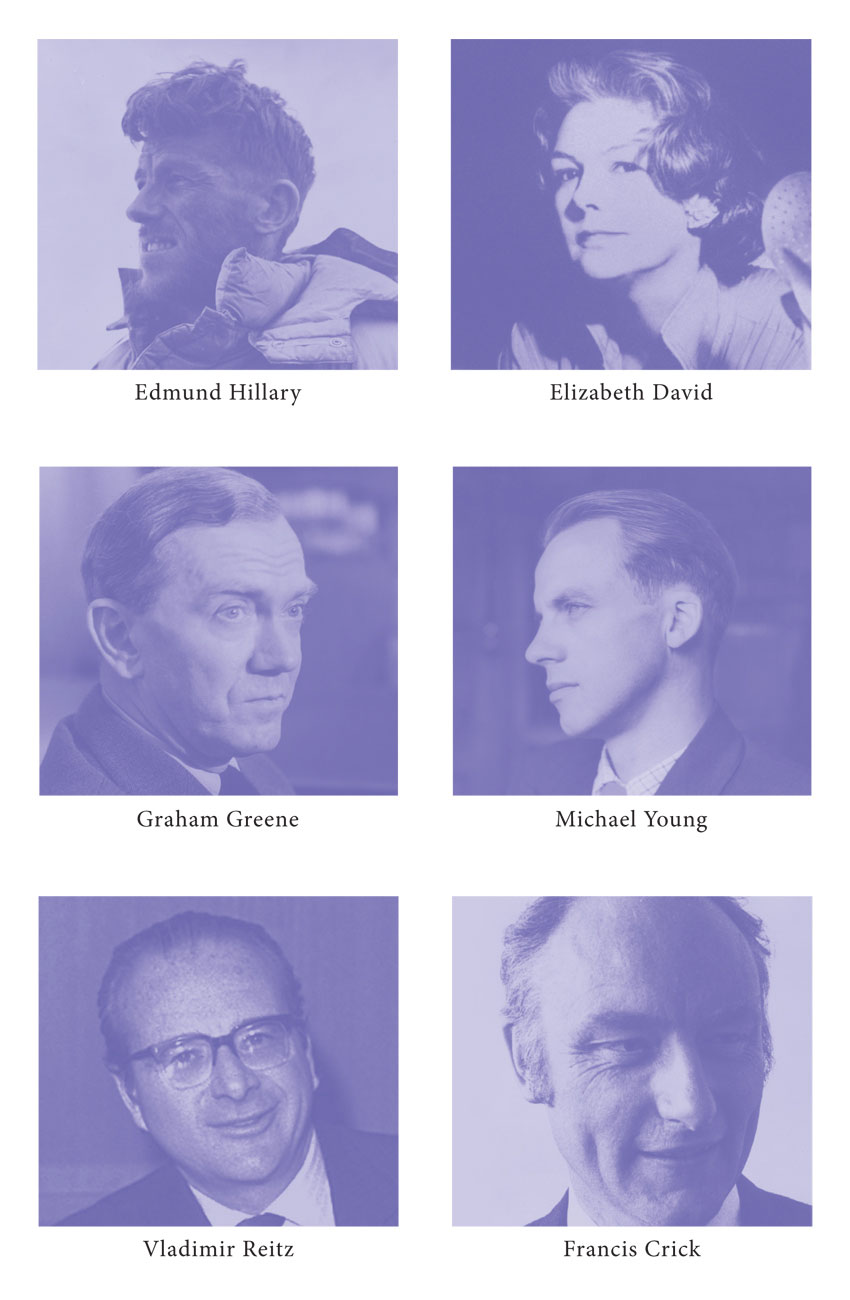
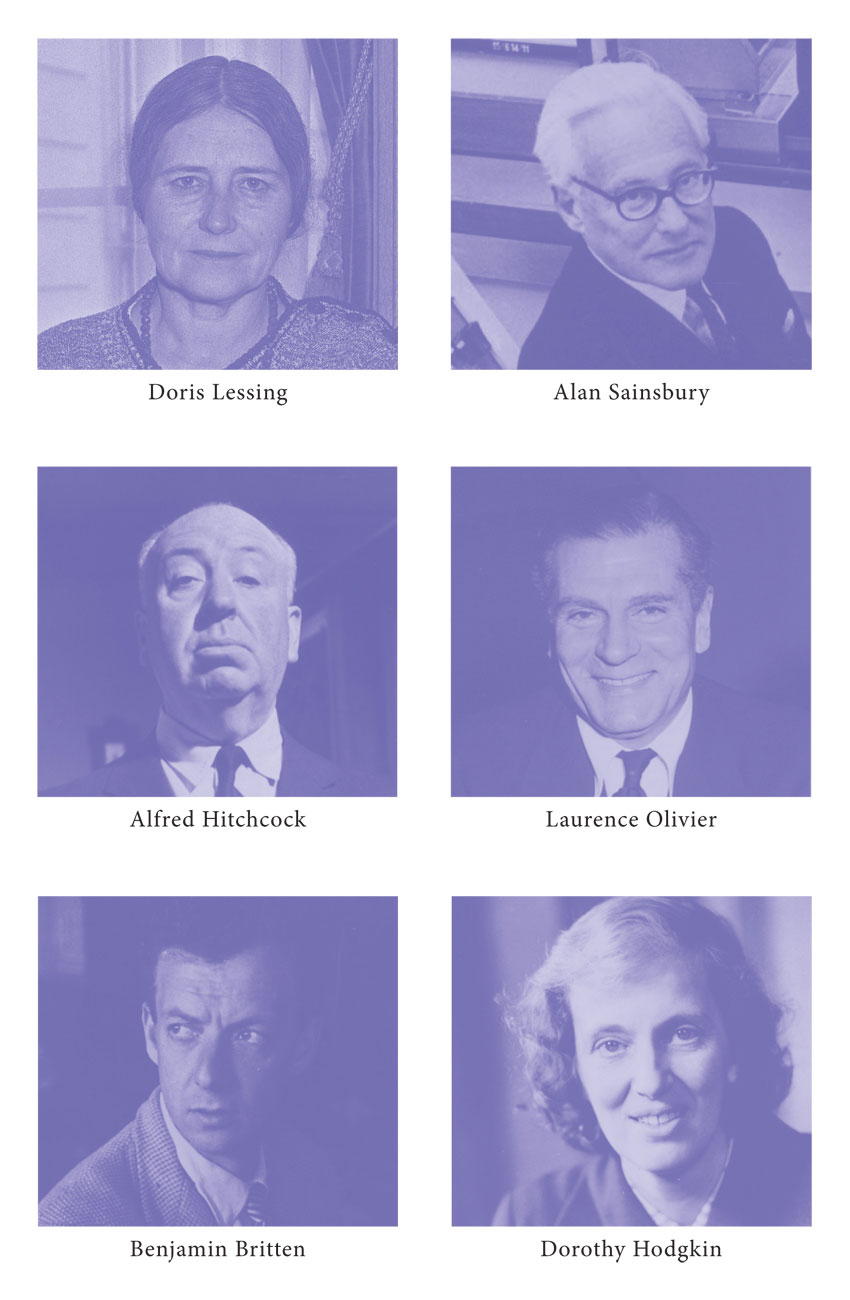

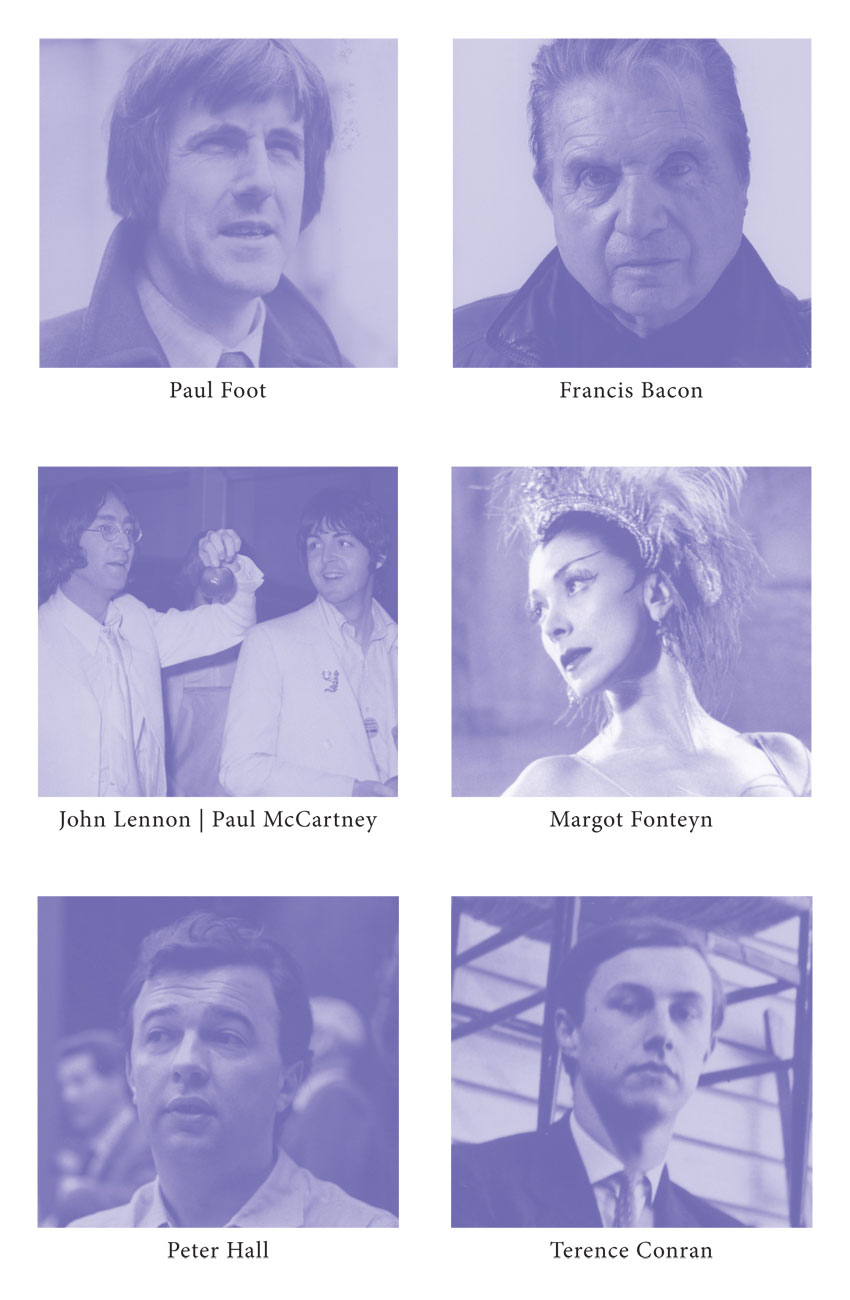
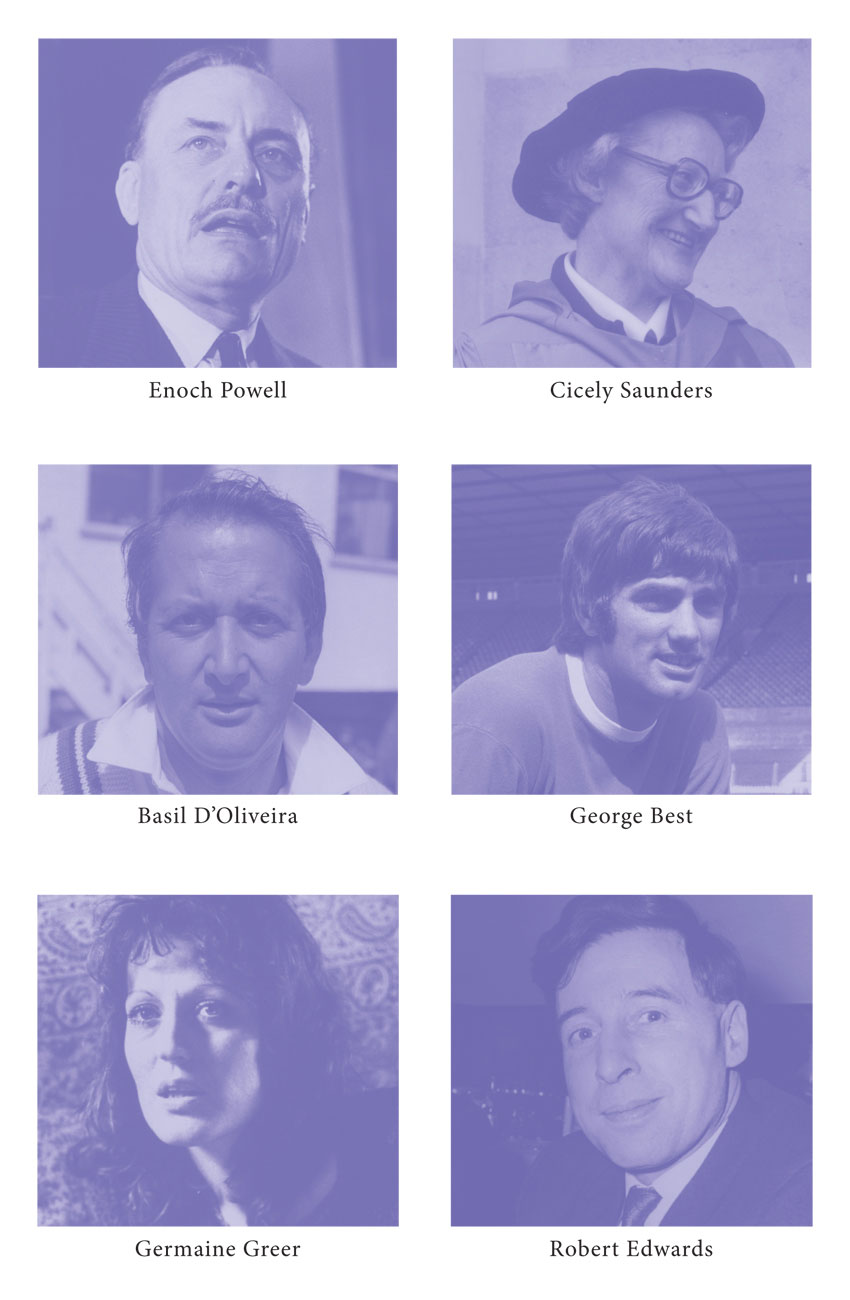
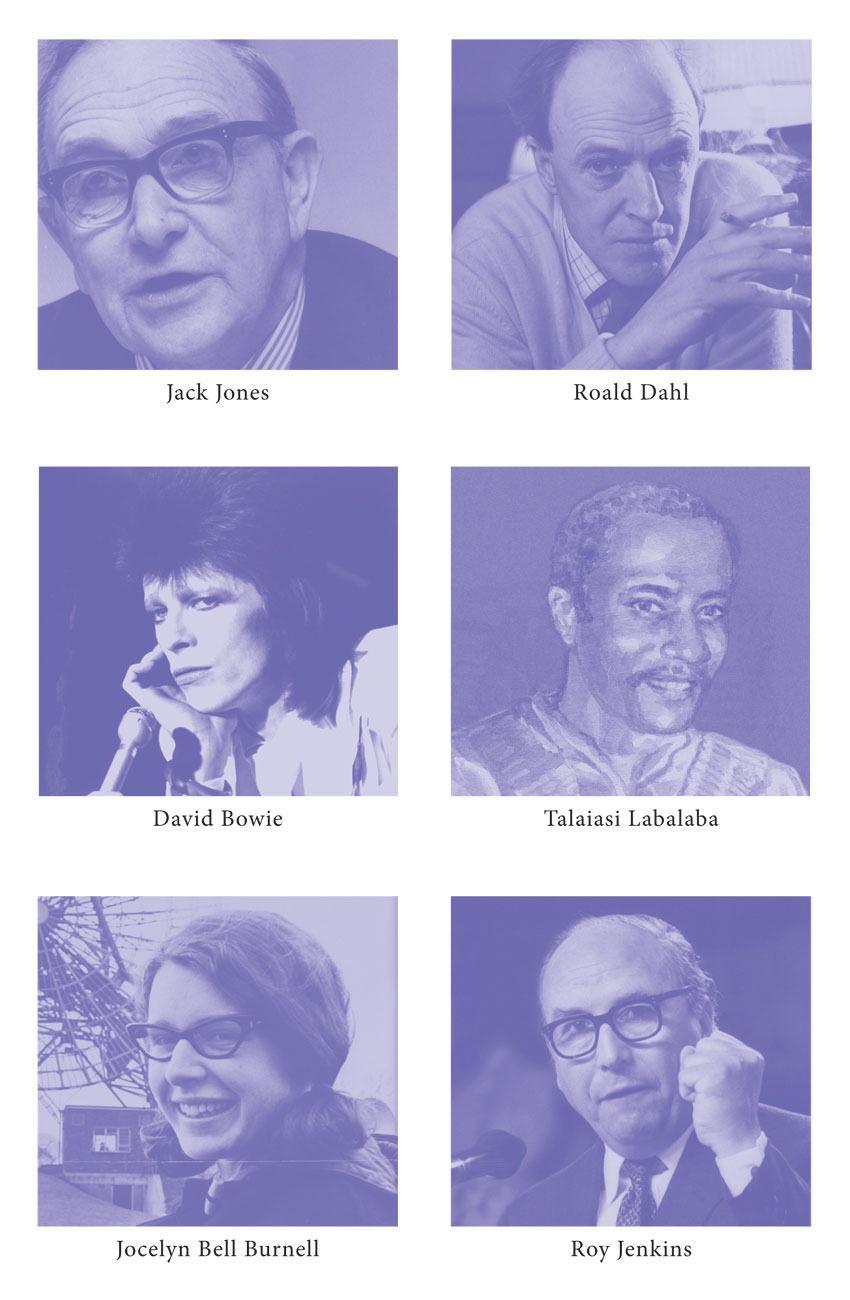
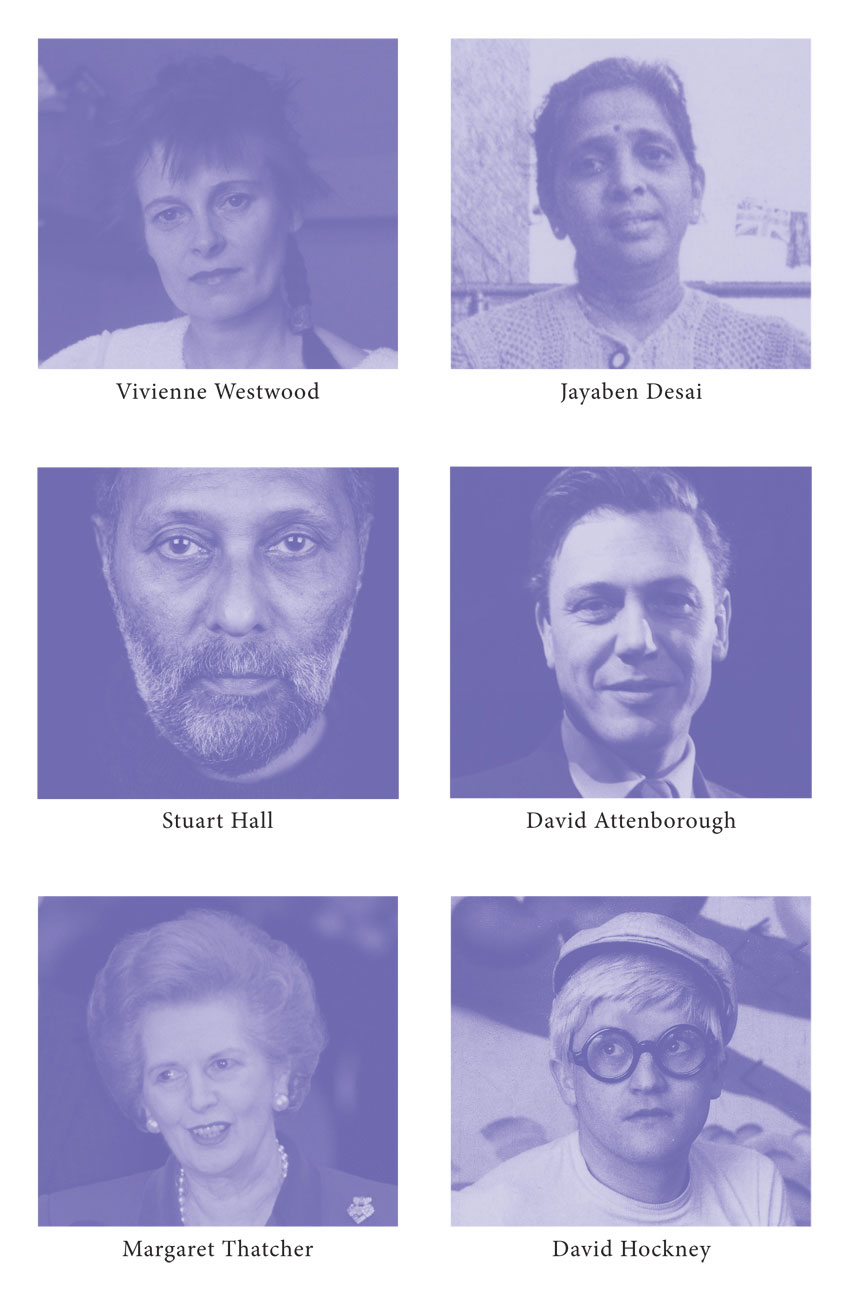
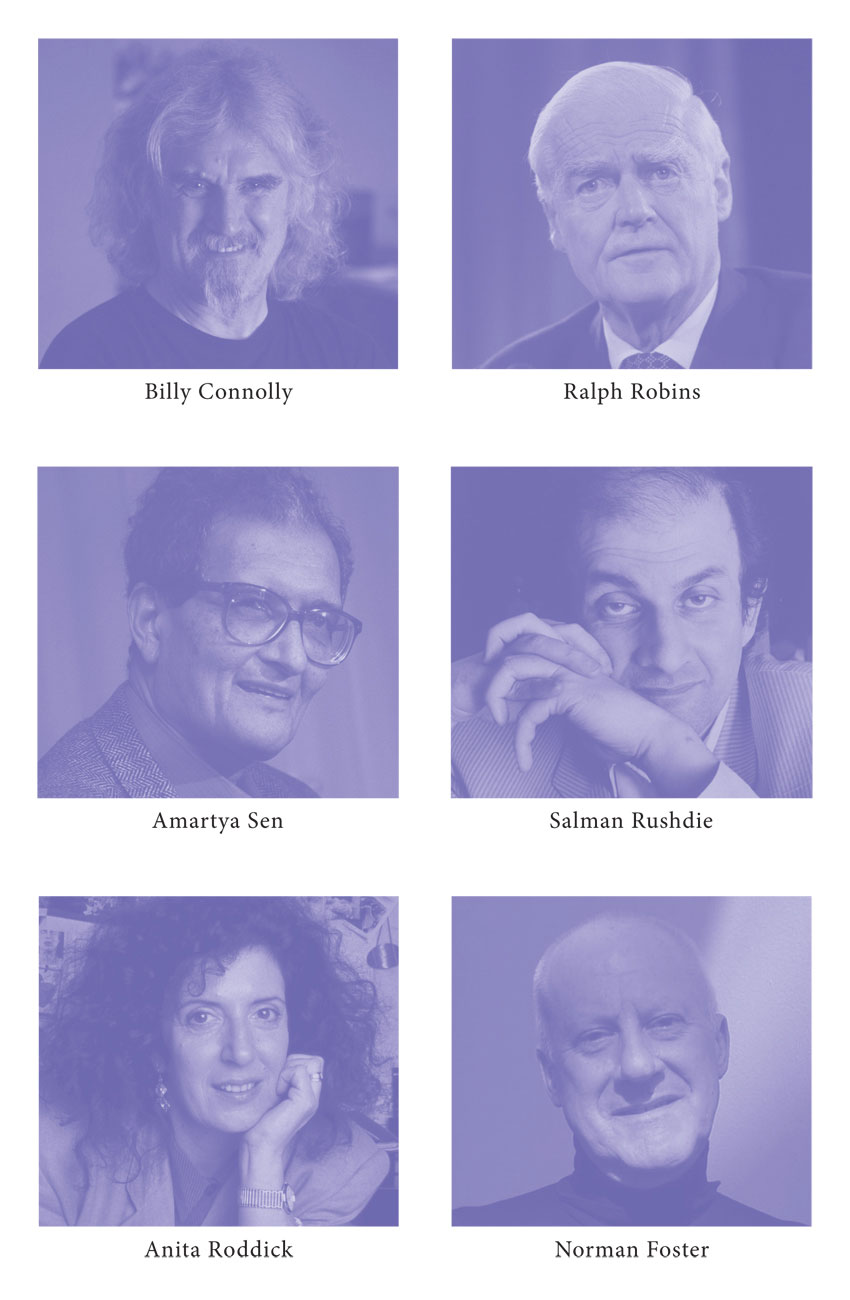
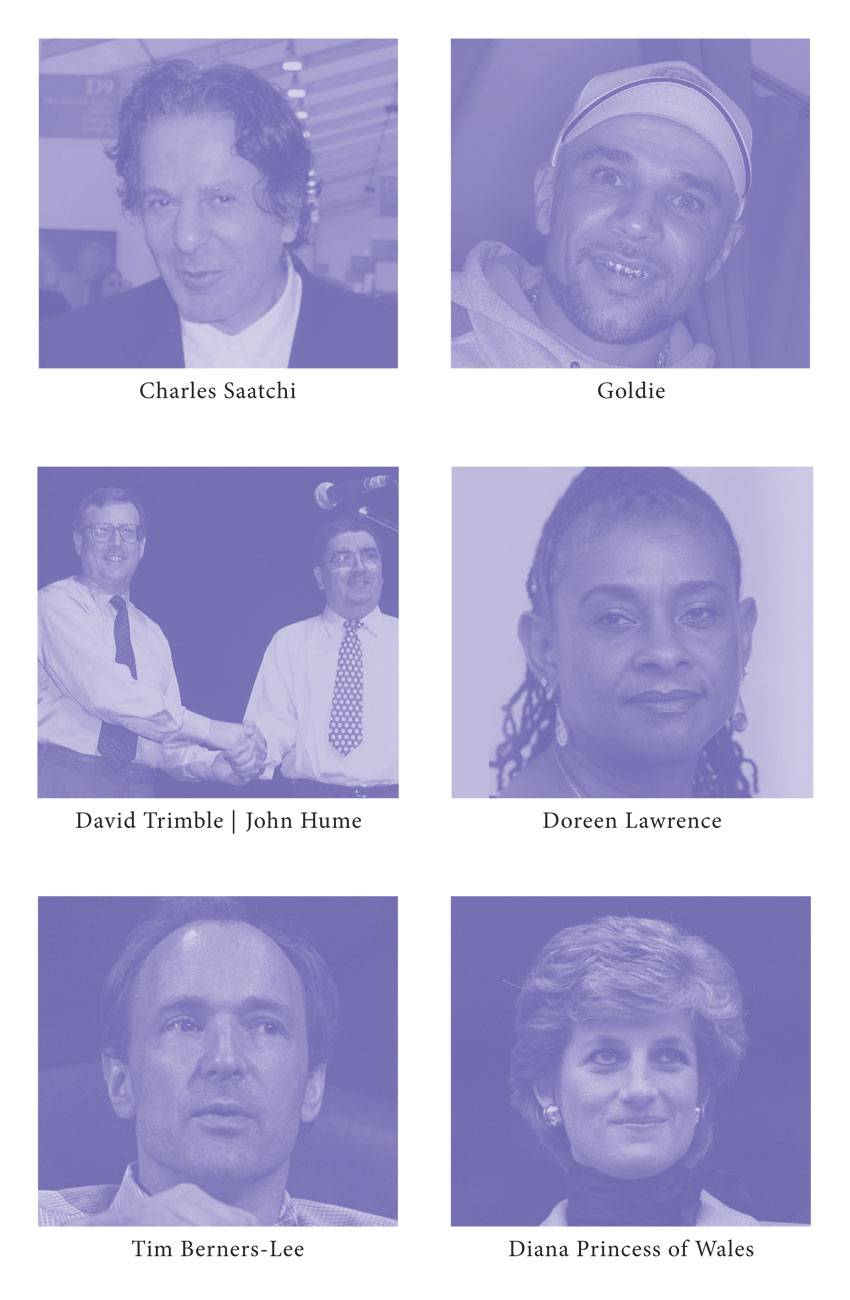
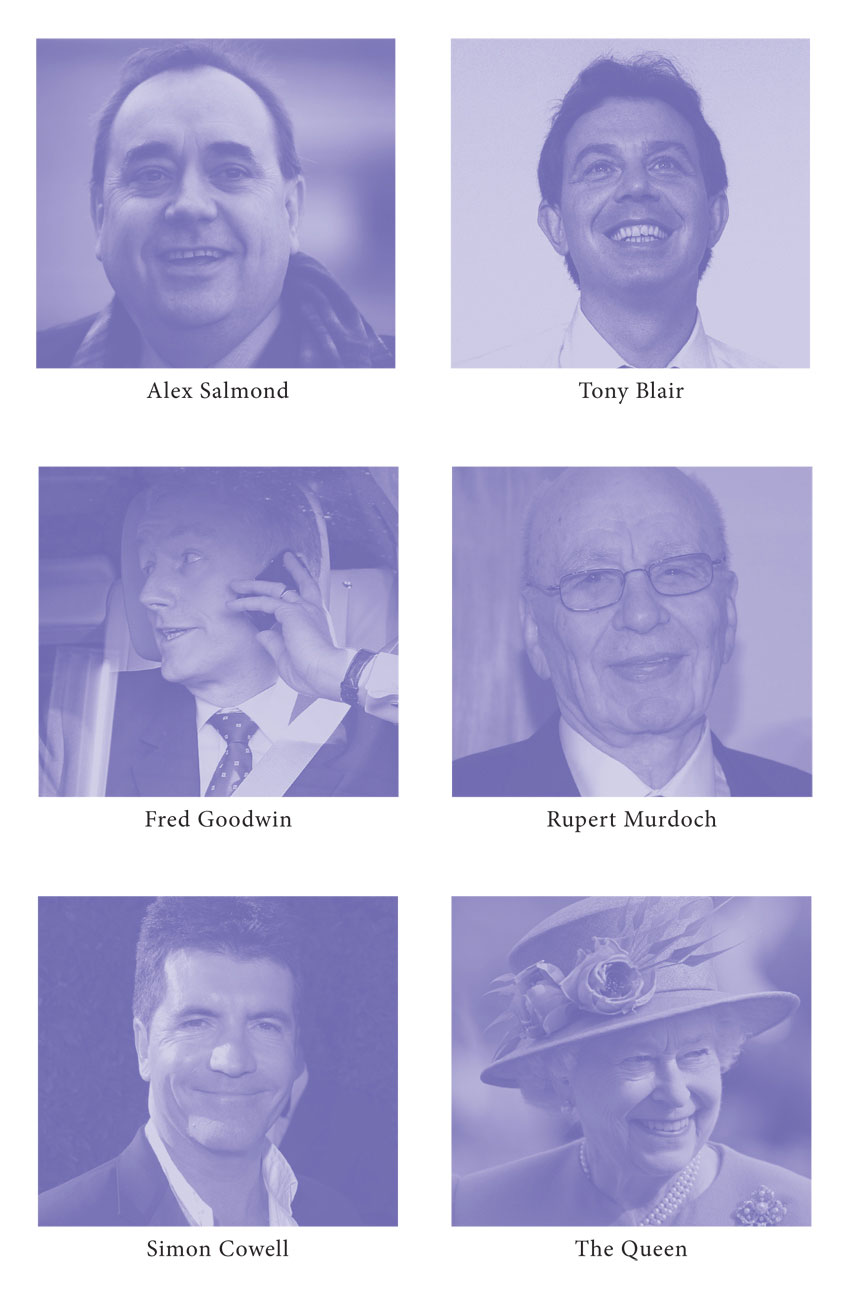
Introduction: Our Age
When the Olympic Games opened in London for the third time in the modern era, there was a surprising outburst of national self-confidence. It was unexpected because a weary habit of apology seemed to have taken hold, over the course of many years, and the relentless flow of dark economic news, rolling in with every tide, might easily have sapped any appetite for celebration. But no. The summer of 2012 turned out to be a festival of confidence, stirring up memories of a time when the country had a sharper sense of itself, and when we imagine that the trains ran on time. Maybe that belief in resilience will turn out to have been another self-deception, but with the coincidence of the Diamond Jubilee to give the era a time-frame, there seemed to be a surprising amount to cherish from years that could too easily add up to an age of decline.
These sixty portraits are reminders of some of the people who shaped these decades, and whose voices were the soundtrack that we all heard. They take us back to the early fifties, and the last days of wartime rationing, into the tumult of the sixties, and then through years that swung from economic crisis to seasons of optimism, and back again.
These people made their mark in a time when our feeling for the past was shot through with self-doubt. In an era of change, when national ingenuity would be tested, a fear of weakness began to spread. British governments since the fifties have had to deal with the awkwardness of an imperial legacy which bequeathed powers that were often illusory. Economic power waned, and the currency – always a token of national strength – shrivelled with the growth of more prosperous rivals. On Coronation Day in 1953, a pound bought nearly twelve Deutschmarks; forty years later, it would get you two and a half. The Royal Navy at the start of the twenty-first century seemed like a flotilla compared with the armada that might have assembled to mark the end of the war in Europe in 1945. And in this new century, after the long era of American dominance, all Europe was preparing for the economic and political consequences of a decisive shift in power to the East. It is natural in an atmosphere of such relentless transition to search for solid ground, and footholds that will guarantee some respite and a chance for reflection.
The subjects of these portraits are useful guides, because their feats – and, of course, their failures – are a reminder of the character of our time. They explain why we were inspired or deflated, why we laughed or wondered, how the age of deference gave way to the culture of youth, how a Prime Minister at the end of the twentieth century could find himself going to war more often than we could have imagined, how the banks imploded, and how a princess could still be turned into a fairy tale in an unbelieving age. They take us into the sunny days that we like to remember, and the shadows too. This is no history, only an album of snapshots of people caught on the run. But together they make up a flickering home movie that is an authentic picture of six decades.
When BBC Radio 4 decided to try to assemble a gallery of New Elizabethans – in sixty portraits, to match the span of the Queen’s reign – it was obvious that they could not be a definitive list of the best and brightest who might be listed in some longer version of the Order of Merit. This would be a selection to represent the contours of the age. They would be from academe and business, politics and science, high culture and entertainment. They had to represent the torrents and the calm of these years, some of the surprises as well as the established achievements. Radio 4 listeners responded to the challenge in their customary spirit, nominating about a thousand individuals in all – many with massive support – and the sifting began.
A panel was brought together with the aim of focusing shafts of light on the list from different perspectives. Tony Hall (Lord Hall of Birkenhead), chief executive of the Royal Opera House and chairman of the Cultural Olympiad 2012, supervised its proceedings with admirable calm. The members were, in alphabetical order: Sally Alexander, Professor of Modern History, Goldsmiths, University of London; Dr Jon Agar, Senior Lecturer in Science and Technology Studies, University College London; Bamber Gascoigne, writer and broadcaster, creator of the Timesearch website, and polymath; Sir Max Hastings, historian and former editor of the Daily Telegraph and London Evening Standard; Dr Anna-Maria Misra, Lecturer in Modern History, Keble College, Oxford; Dominic Sandbrook, historian.
Theirs were labours of Hercules. They were asked to find people on the list who collectively caught the spirit of the age, and to try to ensure that the sweep of the years was represented. Politics shouldn’t dominate, and nor should any other single area of life. They should catch the mainstream, but the awkward currents as well. It was important to reflect popular culture, and not simply award another gong on behalf of Radio 4 to a predictable list of the great and good. And although simple notoriety would not be enough to make you a New Elizabethan, it was important that the list did not consist simply of the sixty people thought to be the most admirable in our time. That meant that there were bound to be some surprising omissions, and inclusions. I attended one of the panel’s meetings – with no formal role – and was aware of the difficulty they faced in being fair and interesting at the same time, trying to represent some of the best and giving a flavour of everything else that we have lived through.
When I began to write these portraits I realized how cleverly they had drawn a line through the years. Like everyone else, I had my favourites who failed to make it round the last bend – that was true of each member of the panel, too – and found some of the names surprising. But together they soon took on the air of a gang of contemporary Canterbury pilgrims, each with a story to tell and throwing light on one another. For example, Enoch Powell, Jayaben Desai, Stuart Hall and Doreen Lawrence cast different shafts of light on the story of immigration and race in our time. And around them clustered the other people who might have been on the journey too, who could be brought in to play their part in the drama. Collectively they made it possible to find an interesting path across the landscape, stopping here and there for reflection, sometimes disappearing into a labyrinth of politics or public controversy, then having a laugh, then discovering the background to a scientific discovery that had been a mystery to me, or uncovering a character of whom I knew little.
The portraits in this collection are reproduced here almost exactly as they were broadcast on BBC Radio 4 through the summer of 2012. Writing for a listener is rather different from writing for someone who will read the words on a page, so there is some informal grammar and sentence structure here that is geared more to the style of a radio talk than a written essay. It seemed sensible, however, to retain their flavour as conversation pieces in this collection. That is how I conceived them, and how they were heard. In nearly every case the archive material added to the scripts for transmission has not been reproduced here, and these are the portraits as they were first drawn.
They are, of course, idiosyncratic. I have tried to be fair, although it is simply not possible to do justice to some remarkable characters in scripts that took only about twelve minutes to read on air, to be comprehensive in explaining their particular achievements. They are personal pictures, and not biographical entries for a journal of record. I hope these are more interesting for having a personal flavour. The series produced lively argument about who was in and who was out, about whether one Prime Minister deserved preference over another, whether just the one footballer deserved the sporting palm, about why there are particular novelists or comedians or musicians who don’t appear in these pages. Good. If our New Elizabethans had been a bore, they would have been a pointless bunch.
I record my deep gratitude to my BBC colleagues in the Acknowledgements, because this was a collective and energetic expedition that proved exhilarating at every turn. I found myself taken back to my youth – listening to Tony Hancock, missing a Beatles concert, learning of the ‘rivers of blood’ speech – and then to the politics that I covered as a young journalist – the first devolution arguments, the rise of Margaret Thatcher – and also discovering characters of whom I knew little, like Vladimir Raitz and his package holidays, or Talaiasi Labalaba, the SAS soldier of whom I hadn’t heard but whose statue is one of his regiment’s proudest memorials. I lived through the Northern Ireland Troubles again, and tried to explain what it was that made Billy Connolly a star.
When it was over, and I was writing about the Queen for the last portrait, I was reinforced in my view that continuity has been as important as change in an era which can be too conveniently defined by decline, crisis and alarm. It is easier to think of the unsolved problems and coming threats than to remember the scientists or artists who startled the world, or the community heroes who fought for human values against a hostile tide. The useful excuse of a Diamond Jubilee, placing our age in a frame, is a chance to try to give the picture its proper proportions, and to see the light and the dark at the same time. It is neither escapist nor nostalgic, just the natural recollection of a journey through the years.
The picture has many layers, and beguiling perspectives. It is both mirror and lamp, reflecting and illuminating, and these are the characters who have drawn it. They tell our story for us.
JN, September 2012
Edmund Hillary
Edmund Hillary was the first hero of the second Elizabethan age. His adventure was organized to make it turn out that way, and to this end the Coronation in 1953 had a piece of news attached that would both announce a new frontier and confirm that the days of unimaginable exploits in far-off places had not gone.
The timing required luck as well as skill and brawn, but it was Hillary’s good fortune to carry with him for the rest of his life the impression that maybe it was because of his dignified bearing and natural modesty that everything had happened just as the expedition, and Fate, had jointly planned: so that there had never been any doubt that when he and Sherpa Tenzing set off for the last push from the South Col they would make it to the summit of Everest.
The truth at the time was different. The winds had been high and the weather bad. The two climbers who had been selected to make the first assault had been beaten back on the last, lonely ridge and at base camp no one could be sure that Hillary and Tenzing would do any better. They spent the last night less than 2,000 ft from the summit, but awoke in the dark just before dawn on 29 May to a calm that brought a surge of relief. The wind had dropped: they had a chance.
Then Hillary saw that his boots had frozen solid in the night and were like lumps of black iron. The first two hours of that day were spent thawing the boots over a flickering stove so that he could get them on. They couldn’t be sure that their oxygen would last; that the weather wouldn’t close in; that they’d have the energy for the last slow slog to the top.
Picture them at the stove: the tall New Zealander and the short, wiry Sherpa, who had been high up the mountain seven times, but never so close to the summit. They had no navigation system, none of the clothing and equipment that would make the next generation of climbers look like quite different animals, not even a radio. Hillary had a little camera tucked under his clothes to stop it freezing up. Their small tent, and the gear they laid out for the last day’s work, would have seemed familiar to the adventurers of a generation earlier, and antique to those who had taken the same route when they had become old men.
The two men preparing for the final trudge to the top were fit and strong, and had the streak of imagination that drives the best climbers to the highest places, where others can’t go. But the expedition – with 362 porters and 20 Sherpa guides – had something of an air of majestic amateurism, connecting it to the memory of wildly optimistic outings when men in hairy socks and polished leather boots forged through the snow or set sail for unknown places. There was nothing ramshackle about the Everest expedition of 1953, planned to the last detail, but the spirit did hark back: to a time when there was no oxygen, patchy maps, and an ever-present feeling of the unknown.
This story had two irresistible elements: ice and suspense. The coldest places on earth had seemed, for more than a generation, to invite the greatest effort of imagination. One of the reasons was the obsession of Captain Robert Falcon Scott. His journeys were the first truly dazzling exploits of the twentieth century as far as any British schoolchild was concerned, and the fact that his fame was sealed by a failure (to beat Amundsen to the South Pole) only proved what a stalwart he was.
Knowing that he was doomed, Scott wrote his Message to the Public: ‘Had we lived, I should have had a tale to tell of the hardihood, endurance and courage of my companions which would have stirred the heart of every Englishman.’
As a youngster in New Zealand, on his two-hour journey to school, Hillary read the stories of such men. Their names cascaded down the years and inspired the expedition put together by John Hunt to conquer the unconquerable mountain, which they all saw as part of an old story – daring and sad. Where Mallory and Irvine were assumed to have failed in 1924, died and lost near the summit without having reached it, there was still a game to be played, and won.
In 1953, time and distance meant that such drama was spun out: no pictures from the scene, no breathless commentary day by day, but weeks of silence. The result, the benefit you might say, was that when good news came, of unexpected progress, or triumph, it came out of a clear blue sky like a roll of thunder. And the Everest expedition had another ingredient that infused the suspense with poetry.
James Morris of The Times was 26 when he was told over lunch at the Garrick Club in London that he could, if he wanted, become Special Correspondent to cover the Everest expedition. The paper had put up some money, and as a result had secured the rights to all the dispatches sent home by Hunt and his men. And in Morris they had found their man, a storyteller of brilliance and effervescent panache whose travels and portraits of people and places would make him one of the most celebrated writers of his age, both as James, and later as Jan, after he decided to become the woman who’d always been inside him.
Morris trekked to base camp with the expedition, though he had no experience of real mountains, and began to plan how he might break the great news, if it came. The problem was that Fleet Street was not going to accept for a moment the deal that The Times had done with Hunt, and dispatched reporters to Kathmandu with instructions to do whatever was necessary to get the story first. You can imagine the Mail and the Telegraph and the Express working on Sherpa guides to make sure that the news would reach them first, perhaps carried on cleft sticks from the slopes of Everest, in an icy echo of Evelyn Waugh’s Scoop.
Morris was up to the task. He described the expedition’s progress to base camp, at 22,000 ft, with elegant verve, and he wasn’t going to let the story slip away. So he devised a code that would confuse any of his competitors who might see the telegram that would be flashed to the British Embassy in Kathmandu: he had no doubt that they would. And with the rest of the expedition, the only reporter in the camp, he waited.
They had no means of knowing that Hillary and Tenzing were on the way, only the knowledge that the wind might have dropped. But they were, carrying heavy backpacks and worried about their oxygen. Hillary wrote of the climb up the last ridge: ‘My solar plexus was tight with fear as I ploughed on. Halfway up I stopped, exhausted. I could look down 10,000 feet between my legs and I have never felt more insecure. Anxiously, I waved Tenzing up to me.’
And they were there, alone. Afterwards, to put an end to the argument about who got there first, they issued a joint statement, saying it was done together. But later Tenzing said straightforwardly that Hillary’s foot was the first on the summit – after, in his words, ‘a few, very weary steps’ – then they joined hands and stood together, never thinking there might be an argument over who got there first.
It was half past eleven in the morning on 29 May 1953 when they unfurled four little flags on a string tied to Tenzing’s ice axe – the Union Flag, and alongside it the flags of Nepal, India and the United Nations, just seven years old. Only Hillary took photographs for a quarter of an hour – so there are none of him at the summit – and they started down.
Tenzing, the Nepalese Sherpa, had climbed the sacred mountain, which had defeated everyone else. He said that in the villages they asked him if he had seen the gods above the clouds. Lord Shiva, perhaps, for that was where he lived. No, said Tenzing, but he had felt a calm that inspired him, and did for the rest of his life.
They took their news down. Morris described seeing Hillary in the half light: ‘Huge and cheerful, his movement not so much graceful as unshakably assured, his energy almost demonic. He had a tremendous, bursting, elemental, infectious, glorious vitality about him, like some burly, bright diesel express bounding across America.’
And then the telegram. ‘Snow condition bad,’ he wrote, which meant ‘Everest climbed.’ In the rest of the message, which said the assault had been abandoned until the weather cleared, he used the code words agreed for Hillary and Tenzing. The rest of Fleet Street, squatting in Kathmandu, swallowed it. The Times had its scoop and on the morning of the Coronation it broke the news. The bells rang out for them.
An answering telegram reached the expedition that day, addressed to Sir Edmund Hillary, the new Queen’s first Knight.
He was a hero for the rest of his life. There were expeditions to both the poles, up the Ganges, back to the Himalayas, but above all for Hillary there was a commitment to the Nepalese people whom he’d come to know on the great climb. The Trust he established built two dozen schools; hospitals, bridges, airfields. He was celebrated as a humanitarian, and never lost the straightforwardness of the man who said he had always hated the ‘danger part’ of climbing and thought that the greatest of all feats was the comradeship that built up in the lonely places. ‘The giving of everything you’ve got,’ he said, ‘is really a very pleasant sensation.’
Edmund Hillary, adventurer, scientist and beekeeper, died in 2008, aged 88.
He once said that in honouring explorers from the past people should remember that it was ‘still not hard to find a man who adventures for the sake of a dream … or one who will search, for the pleasure of searching. Not for what he may find.’ That was the spirit Hillary tried to bring to his time.
Elizabeth David
When Elizabeth David began to write her first book for the British on the food of the Mediterranean, her readers were still disentangling themselves from wartime rationing. Olive oil was something you bought at the chemist, with a warning on the little bottle: ‘For external use only.’ She was going to raise their sights, even though she must have known that very few of the home cooks to whom she was addressing herself would have the inclination, let alone the appetite, to follow her instructions for stuffing a whole sheep. Yet that is what they might have done on the Greek island where, as a young woman, she had decamped at the end of the thirties with her married, older lover and where she consummated a life-long affair with food.




